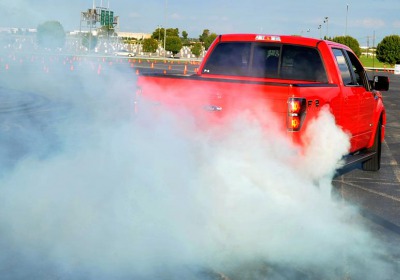2011 Ford F-150 powertrain lineup overhauled
Thu, 23 Sep 2010WITH VIDEO -- A V6 in America's best-selling pickup? Ford enthusiasts know there has been a six-cylinder engine available in F-Series pickups most years since the truck's debut in 1948. But never has so much combustion efficiency been seen in any of them until now.
Ford's 2011 F-150 will get two new V8s and two new V6s in the next few months, the biggest engine makeover ever for America's biggest-selling truck. During a press introduction in Texas, we got to talk to several engineers at Ford about the new powerplants. We also got to drive most of them, but we can't tell you about that until Monday. So here's some more info on the engines.
The most interesting powerplant is easily the 3.5-liter EcoBoost V6. Like every other carmaker on the planet, Ford has to figure out ways to meet looming CAFE standards that keep going up. That and the just-confirmed loss of the Ranger pickup after the 2011 model year mean another V6 engine was due. But the last V6, a 202-hp 4.2-liter offered in 2008, accounted for just 15 percent of sales. Ford wants this and a 3.7-liter V6 also being offered to account for 50 percent of F-Series sales. That's a huge leap. To make sure buyers scoop up enough V6s to put a real dent in those CAFE numbers Ford had to make its V6 offerings strong. And they are, particularly the EcoBoost.
The twin-turbocharged EcoBoost V6 makes 365 hp at 5,000 rpm and a whopping 420 lb-ft of torque at 2,500 rpm. Ninety percent of that torque is available from 1,700 to 5,000 rpm. That's enough to tow 11,300 pounds and, at least on paper, silence any critics who claim they "ain't buyin' no dang V6."
The 3.5-liter EcoBoost also powers the current Taurus SHO, Ford Flex and Lincoln MKS and MKT.
The engine is loaded with high tech componentry that would have seemed like science fiction to the engineers who built the flathead straight six of the 1948 model year. Ford's twin independent variable cam timing adjusts the phases on each camshaft by up to 60 degrees on the intake cam and 50 degrees on the exhaust. BorgWarner makes the two turbochargers--one for each bank of cylinders--that add up to 13.5 psi of boost to the combustion process. An intercooler sits up front, sharing grille space with the radiator. Direct injection blasts fuel into the combustion chambers at 2,100 psi. Cast iron exhaust manifolds are durable and help with catalyst light-off. Computer mapping for the turbo is unique to the F-150.
"Truck customers should think of the EcoBoost truck engine as a gas-powered engine with diesel-type capability and characteristics," said Jim Mazuchowski, V6 engines program manager. "The twin turbochargers and direct injection give it the broad, flat torque curve that makes towing with a diesel so effortless--and hard acceleration so much fun."
But the EcoBoost V6 engine and its peripheries weigh about the same as the previous 5.4-liter V8, so there's no loss of curb weight based on having two fewer cylinders.
The other V6 is Ford's naturally aspirated 3.7-liter unit shared with the Lincoln MKX, Ford Edge Sport and Ford Mustang. This base engine delivers 302 hp and 278 lb-ft of torque. The cylinder heads and the whole air system are new. The camshafts have longer lift and the compression ratio is bumped up from 9.8:1 in the other applications to 10.5:1 for the truck. It has a tow rating of 6,100 pounds.
Ford also improved the truckliness of the 5.0-liter V8 from the Mustang, mostly by upgrading the structural integrity of the aluminum block. Engineers added beefier bulkheads in the bottom end and ribbing on the outside, the latter which helps reduce engine noise. Compression ratio was lowered from 11:1 in the Mustang to 10.5:1 in the F-150. They reduced the duration of the intake cam as well. Exhaust manifolds are cast iron instead of tubular steel. And an oil cooler was added for towing, something the Mustang doesn't normally do.
Finally, the 6.2-liter, normally aspirated gasoline V8 is pulled straight from the SVT Raptor. The engine is strong, according to Ford engineers, with a cast-iron block, six-bolt mains, two side bolts per cap and five main bearings. The rods are forged, the crankshaft is cast and the pistons have sculpted skirts that reduce reciprocating masses while helping avoid slap. Exhaust manifolds are cast iron. The single overhead cams have variable cam timing and roller rockers operate the two valves per cylinder. There are also two spark plugs per cylinder.
All four engines are mated to the same design six-speed automatic. Only the torque converters are unique. As with most six-speed automatics, you gotta think it was done just for CAFE, like seemingly everything nowadays.
The EcoBoost V6 will be available in early 2011, likely February, while the other three powerplants will be in showrooms by the end of this year.
One interesting thing not addressed adequately at the Texas hoe-down was fuel economy. Ford would only make vague verbal gesticulations about "best-in-class" and promises of a "20-percent improvement over (take your pick) the competition or current V8s." Real numbers would have helped their case, unless real numbers don't impress.
More on the F-150 Monday, including driving, dragging and towing impressions.
Watch Mark Vaughn's video tour of the engine lineup for the 2011 Ford F-150:
By Mark Vaughn



